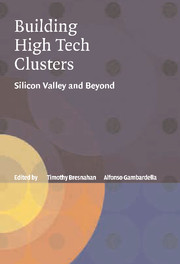Book contents
- Frontmatter
- Contents
- Preface
- List of Contributors
- Building High-Tech Clusters
- 1 Introduction
- 2 Learning the Silicon Valley Way
- 3 Israel's Silicon Wadi
- 4 In the Footsteps of Silicon Valley?
- 5 Agglomeration and Growth
- 6 Clusters, Competition, and “Global Players” in ICT Markets
- 7 Taiwan's Hsinchu Region
- 8 The Role of Government in Regional Technology Development
- 9 Imitating Silicon Valley
- 10 Old-Economy Inputs for New-Economy Outcomes
- Index
- References
4 - In the Footsteps of Silicon Valley?
Indian and Irish Software in the International Division of Labor
Published online by Cambridge University Press: 05 June 2012
- Frontmatter
- Contents
- Preface
- List of Contributors
- Building High-Tech Clusters
- 1 Introduction
- 2 Learning the Silicon Valley Way
- 3 Israel's Silicon Wadi
- 4 In the Footsteps of Silicon Valley?
- 5 Agglomeration and Growth
- 6 Clusters, Competition, and “Global Players” in ICT Markets
- 7 Taiwan's Hsinchu Region
- 8 The Role of Government in Regional Technology Development
- 9 Imitating Silicon Valley
- 10 Old-Economy Inputs for New-Economy Outcomes
- Index
- References
Summary
It is commonly believed that economies based on information technology (IT) are different from the “old” economies – different in cost structures and the role of human creativity, even in management styles, business models, and the role of entrepreneurial entrants. This chapter explores the implications of these differences for economic development models by studying the software industry in two follower countries, India and Ireland.
The dramatic growth of IT in the advanced industrial nations had two features that were of great importance for follower countries: the decoupling of hardware from software, and the pronounced human capital intensity of software. Together with the rapid improvements in data communications (and communications more generally) and the steady increase in globalization, these features opened a window of opportunity for countries well below the technology frontier but rich in human capital relative to the opportunities for that human capital. But all countries that fit the bill have not been able to seize the opportunity or have done so in ways that differ from each other in a number of important respects.
Although India and Ireland are different in many respects, especially in size and development stages, along with Israel they are the most prominent examples of countries that appear to have benefited from this window of opportunity. Both specialize in software and IT services and have benefited greatly from the increased international demand for software workers.
- Type
- Chapter
- Information
- Building High-Tech ClustersSilicon Valley and Beyond, pp. 78 - 120Publisher: Cambridge University PressPrint publication year: 2004
References
- 10
- Cited by

